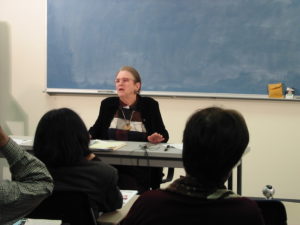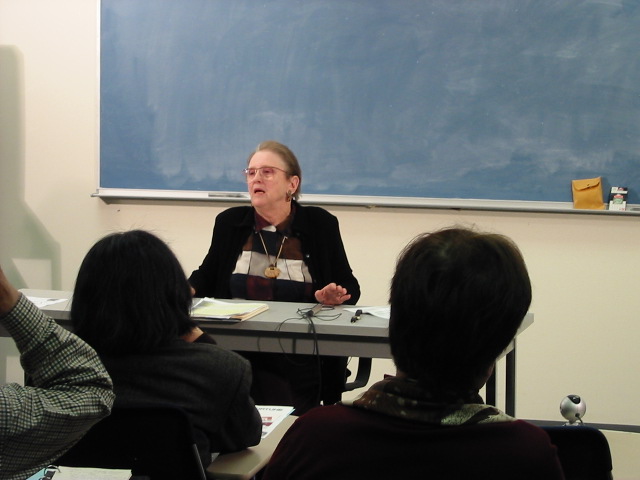
An important ancient set of east/west north/south highways traverse countries and cultures in Asia from China to the Mediterranean, yet they have no particular name. Now everyone knows them as ‘The Silk Road.’ They exist from antiquity, are popular and well-traveled, and are named in German in the 1870’s by Baron Ferdinand von Richthofen as ‘Seidenstrasse.’ The name sticks.
A lot has been written about these land routes. They tell about a large diversity of people, products, and persuasions found on them. They cease to be well-traveled some time after the Yuan Dynasty (1279 – 1268 C.E.) when sea routes make travel faster, less expensive, and safer. Interest in the travelers and where they travel seems dormant these past hundreds of years until in 1998, Yo Yo Ma initiates a ‘Silk Road Project.’ This world-famous cellist sees the Silk Road as a metaphor for cultural exchange and even calls it ‘the internet of antiquity.’
This particular talk,. “Savoring Diversity on the Silk Road” looks at when and what, and openly wonders why as early as the second century B.C.E. diverse cultures connect places such as Rome and Han China yet still remained ignorant of each other. It emphasizes the food information found in the writings. It looks at where, why, and which ones were eaten and traded on these multi-cultural meandering routes.
For China, it all begins on its western border with skirmishes that put the Empire in danger. Emperor Wu Di and his generals notice and hear about nomads and military folk who ride very fast horses. They are envious and want some so Wu Di sends an emissary, Hang Qian, and a hundred men to explore and report back. He returns thirteen years later with only two men left having spent almost all that time in jail. He comes back with tales and two food items, grape seeds (and how to make grape wine) and alfalfa (and how to feed it to horses). The Emperor is disappointed and instructs General Li Kuang-li to acquire those horses quickly; and he succeeds. In a matter of months he is back with thirty fast now named ‘heavenly horses’ and he opens trade routes that put portions of what later becomes the Silk Road under Han control.
Silk is traded on these routes and the Romans want lots of it. Though now easily accessible to the west, how to make silk remains an Imperial secret until some Nestorian priests hollow out their canes and stuff cocoons into them. This brings technique and the tools to make it to the west. Silk is but one thing of interest on these routes. Central Asia teaches Chinese and others to make and eat flat breads and how to capture, raise, roast or grill sheep. There are other culinary transfers. The Chinese teach Persians and others about various kinds of rices, about spices, and about many other fruits and vegetables. They also teach each other about different beverages and other foods.
In early and later years, the diversity of foods and goods expand China’s larder. Moving east or west are fruits, vegetables, all sorts of animal foods, many herbs that accompanied the spices, and how to prepare each of them. During these times there are actual intermarriages of people and lots of exchange of products. There is trade in horses, jade, gems, glass, laquer, tea, cotton, ivory, wool, and linen, and of course silk. Religions are traded, too. People learn about and practice all or parts of Buddhism, Christianity, Judaism, Islam, Zoroastrianism, Nestorianism, Hinduism, Jainism, Manichaeism, etc.

In these times, eating along the way is done in wine houses, small eateries, and at eateries connected with the night markets. Most is done in oasis towns from Chang-an (now known as Xian) to Kasgar and beyond. At these places, travelers and locals get wholesome food, some inventive, most different from what they are used to. Most places prepare only a few items but people are free to and do try different items in different places. The small eateries eventually give way to larger individual restaurants that serve foods of Central Asia or Chang-an, Sichuan, Shanghai, Guangzhou, Beijing, etc. The Chinese eat the varied non-Chinese foods and when they get home they want to eat them again. This means bringing ingredients, even cooks, with them so they can. Thus foods and culinary techniques make their way to other regions.
It is interesting to note that those espousing strong Buddhist beliefs find places that feature vegetarian foods, those practicing the tenets of Islam find places where pork is prohibited, etc. And, caravan drivers-many Uyghur or Mongolian–for whom neither of these beliefs mean anything–find large amounts of grilled meats and cauldrons filled with meat stews. Virtually any kind of food and drink can be bought or traded for and those who travel these routes have opportunities to eat a large variety of different foods. They do so when caravan drivers, their staffs of assistants, other merchants, nomads, and military sorts stop to sell or exchange goods and take on more provisions. There are many times and many places to do this. The routes are long and arduous and five months is typical to go from one end to the other. That means some goods have a better chance of making the entire dangerous journey than those who buy and sell them.
From early writings and monasteries recently unearthed, much is learned. For example, some way-stations only served vegetarian foods, others cater to Mongolian travelers and serve large pieces of meat or skewers of barbecued yak, mutton, or horse meat. It seems that all of them provide many kinds of fermented beverages along with women and song. Much is been written about these song and dance evenings when a popular drinks made of fermented mare’s milk, now called koumiss, is enjoyed. Another popular beverage, no name given, is made mixing rice, millet, and honey. These and other drinks can be had with or without an alcoholic kick. To go with them are sausages made of horse intestine and huge pieces of mutton served with salt and water, some millet and wheat flour noodles and dumplings, and many different grilled small animals. For the road, they pack dried meats and dried fruits, and fresh and dried vegetables, and animal hides filled with various liquids.

We know about the Silk Road from writings and from items at burial sites. We know of them from a couple of famous travelers who report about foods along them. One is William of Rubruck, the French Franciscan monk-emissary to the Chinese, sent by King Louis IX, another is Marco Polo, an Italian. There are others, too, who write about these ancient trade routes and the diverse peoples and foods, Islamic, Asian, and Middle Eastern, on them. All of the foods have a major impact on China’s eating habits. Many turn up at Tang Emperor courts and among the Tang elite. Then, when the Chinese overthrow the Mongolians at the end of the Yuan Dynasty, their strong distaste for conquerors make them discard most non-Han foods.
Dr. Newman’s talk provides a list of a few important books about China and the Silk routes, a few maps of the early and later trade routes, and a list of foods eaten on silk routes that remain and those no longer eaten by the Chinese. She also provides five updated versions of recipes eaten on the Silk Routes.
Copyrighted by Jacqueline Newman, 2003

